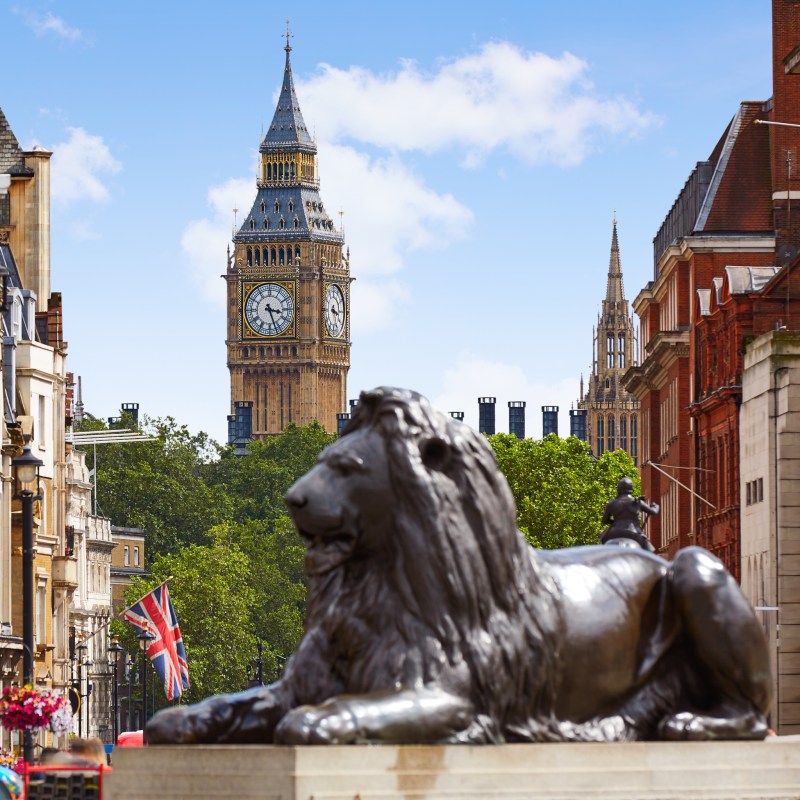
Trafalgar Square is an enduring symbol of Britain and the center of tourist London.
Videos by TravelAwaits
It’s been a key landmark in the history of the country’s social movements, a place of celebration and life, and one of those spots that just tends to draw people. Every year, it boasts a lovely Christmas tree, a gift from Norway.
The nearest stations are Charing Cross, Piccadilly Circus, and Leicester Square. Buckingham Palace, Westminster Abbey, and the Houses of Parliament are all within walking distance.
Trafalgar Square is located in the famous West End of London, where theater lovers have their pick of fine performances featuring some of the world’s best actors.
What draws me to the square time and time again is the people-watching, the daily drama, and the history. I’m a bit obsessed with it.
Here are 13 reasons you should make time for a visit on your next trip to London.

1. Central Location
The wonderful thing about Trafalgar Square is that it’s at the very heart of the city. The center of London is located right beside the square, on a traffic island at the south end. Search for London in Google Maps, and you’ll see what I mean.
2. King Charles I Statue
On that traffic island, there’s a bronze statue of a man on a horse looking downhill toward the Houses of Parliament. This is King Charles I. During the English Civil War, he was beheaded in 1649 at the Banqueting House, one of five Historic Royal Palaces in London. You can almost see it from here.
The statue, from about 1633, was thought to have been melted down during the war, but it was actually hidden away. It was placed here in 1675 after the restoration of the monarchy.
3. The Charing Cross
Nearby Charing Cross Station has an ornate sculpture of a cross in front of it, but that cross is not the actual Charing Cross, nor is that station actually at Charing Cross.
In the 1290s, an ornate stone cross was erected at the hamlet of Charing, where the traffic island is now. After Queen Eleanor of Castile died, her body was brought to Westminster Abbey for burial. At each overnight stop on that journey, the brokenhearted King Edward I had a cross erected.
The Parliamentarians, an anti-Royalist faction, pulled down the original Charing Cross in 1647. The fancy new cross in front of Charing Cross Station is an 1865 replacement.

4. Former Home To The Royal Garage
Until 1820, Trafalgar Square was the site of the Royal Mews, where the stables, carriages, and horses of the royal household were kept. King George IV moved the mews to Buckingham Palace.
Trafalgar Square is now dominated by monuments, but it started as an urban redevelopment project back when King George IV and his architect John Nash were reshaping London.
5. Namesake Of Great Naval Victory
Britain and France were at war frequently during the 1700s and into the 1800s. An island nation, Britain relied heavily upon the Royal Navy for protection against invasion and blockades.
In the early 1800s, Napoleon’s French army seemed unstoppable on land. Of course, the French wanted to control the sea as well. It was not to be.
On October 21, 1805, the British, under Vice-Admiral Horatio Nelson, decisively defeated the French in the Battle of Trafalgar. That battle, off the southeastern coast of Spain, turned Nelson into an even greater national hero than he already was and made the name of Cape Trafalgar famous.
The Napoleonic Wars continued for 10 more years. Years after that, in October of 1832, Trafalgar Square was named for the famous victory.

6. Nelson’s Column
Mention Trafalgar Square, and the next thing you’ll hear about is Nelson’s Column.
High on a granite column stands a sandstone Admiral Nelson in uniform, wearing a two-cornered hat. The sculptor, Edward Hodges Baily, made the eyes blank. One of Nelson’s eyes was blinded in battle.
One of Nelson’s hands rests on a sword; the other sleeve is empty, since he lost an arm in battle. By the time of the Battle of Trafalgar, Nelson was half-blind, one-armed, and still suffering from the severe seasickness he’d had his whole life.
Nelson’s Column is so tall (almost 170 feet from the ground to the top of his hat) that from below, the statue looks life-size. It’s actually about three times that.
Bronze plaques on the pedestal depict four of Nelson’s famous victories. The four guardian lions by landscape painter Sir Edwin Landseer were installed later.
7. Other Nautical Connections
Besides its association with Nelson and Trafalgar, Trafalgar Square has other connections to the sea. Admiralty Arch, built in 1912, is nearby, and so is The Admiralty pub.
The square’s two reflecting ponds and fountains were dedicated to Admirals John Jellicoe and David Beatty, commemorating the Battle of Jutland in World War I. The third bust near theirs is of Admiral Andrew Cunningham, commander-in-chief of the Mediterranean Fleet during World War II.
8. Other Historical Statues
Three of the four pedestals in the square hold statues. The first one depicts King George IV on horseback. He was terribly extravagant and vain.
On the next two pedestals are statues of Generals Sir Henry Havelock and Sir Charles James Napier, who died in the 1850s.
The fourth pedestal has become a platform for new art.

9. Million Of Annual Visitors
In 1843, more than 100,000 people came to see Nelson’s statue in the two days before it was raised. That’s a lot for a square measuring only 360 feet on each side, minus the area taken up by the ponds.
The ponds may have been meant to prevent crowds from gathering, but that has never really worked. A popular event like the annual Passion Play can bring in 20,000 people. The streets surrounding the square can hold thousands more.
As far as day-to-day traffic goes, I’ve seen one estimate that claims 15 million people visit Trafalgar Square annually.
10. Demonstrations And Celebrations
There are quite a few things you are not allowed to do under the Trafalgar Square bylaws, like swim, camp, feed the birds, or climb on the lions.
Demonstrations may be permitted by the mayor of London and frequently are in support of the tradition of Trafalgar Square as a center of national democracy and protest.
Although Trafalgar Square is well known for demonstrations and protests, there are no plaques or monuments to the many crusaders who have come here to make a point, nor to the hundreds of thousands of people who have marched through.
On a much lighter note, the July 1 Canada Day celebrations in Trafalgar Square are a lot of fun.

11. Near Many Tourist Destinations
Visit The National Gallery on the north side of the square to see fine paintings from the 13th through the 19th century. Admission is free. The well-stocked shop has a selection of specialty art books and souvenirs.
At the nearby church of Saint Martin-in-the-Fields, you can catch a concert, get a meal at the Cafe in the Crypt, or create your own souvenir at the Brass Rubbing Centre.
The South Africa House is decorated with sculptures of plants and animals. I love the gold art deco springbok.
Across the square, the Canada House is less fancy, but it’s my favorite building there, because I’m Canadian.
12. Inclusive Pedestrian Crossing Lights
A few years ago, the pedestrian crossing lights around Trafalgar Square were changed from the usual green men to symbols representing various types of relationships.
13. A Few Secrets
Here are a few lesser-known things about Trafalgar Square. This information might just help you out with pub trivia!
- The brass plates on the ground at the north end are the official measurements of length according to the Imperial system, including archaic units like poles and perches as well as the more familiar feet and inches.
- You may have heard about a tiny police station at the southeast corner. It was actually a police call box, now in use as a cleaner’s closet.
- Underground streams used to feed the fountains.
- The Landseer lions replaced an earlier set, now on display in the model Victorian town of Saltaire.
- A statue of General Charles George Gordon once stood between the fountains but was moved to the Victoria Embankment.
- The first fountains, replaced by the current ones, are now located in Ottawa and Regina, Canada.
What To Know Before You Go
Beyond the square itself, this part of London is fun to explore. The National Portrait Gallery and the unique shops of Cecil Court are just steps away.
There are public toilets and a cafe at the north end of Trafalgar Square. The National Gallery has a fancy restaurant and a coffee shop.
Trafalgar Square is level and flat, with an elevator at the north end for those who can’t manage the stairs.
